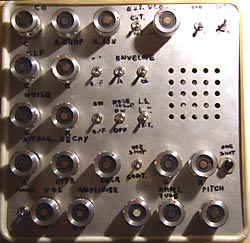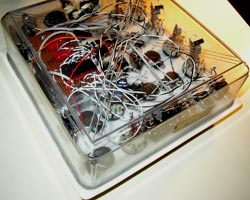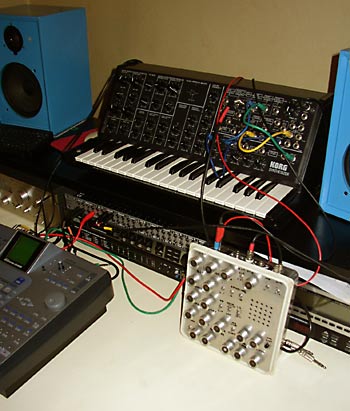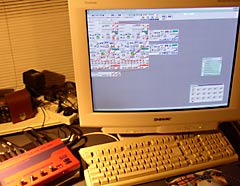Sound Experiments
ADD - Analog to digital to digital
Introduction:
I've noticed people are interested in the self-built synth i got. Quite right, because it looks pretty weird!
And at the moment i'm also deeply into my newly acquired, second hand, Clavia Nord Micro Modular.
It has great flexibility and ease in designing your own patches. It's remarkable and i wonder why not all synth manufacturers make something similar.
I like to take the opportunity here to use both. And i also hooked up some other stuff. Here i'll show you what i did and finally you have the option of downloading a result to get an idea of what it all sounds like.
Backgrounds:
On the home-built synth:
I have put it in a cheap breadbox, all the other parts are mostly from the Amsterdam Waterlooplein. There is nothing to be found there today, but i used to have at least three great sellers of electronic parts! Always a sure thing spending my pocket money on a train ticket from Utrecht to Amsterdam.
But for this special project i got money from my parents. It was to have something to do over the summer holidays, which we spent in Britanny, France. So basically i brought everything along. But i had to get some extra parts in France as well. No worries, with a little french and a lot of electronics enthousiasm you can get anything! My parents where dumbfounded as they really didn't understand what i was on about and then that store guy smiling and running to get things :)
Now, this synth is based on an integrated circuit by Texas Instruments, the SN76477. It contains an VCO, LFO, noise and a basic envelope generator. No filters. And it was all done with pulse width modulation and therefore sounds very 'raw'. If you look at the waveforms on an oscilloscope it's all twisted and spiky. I think it was developed initially to be placed in childrens' toys. You can get great whisles, steamengines, helicopters etc. from it. But it was soon picked up by amateur synth builders as it's realtively cheap and easy to build something with it.
|

Closeup..
|

Backup!
|
On the Nord:
I used the Nord just as a filterbank. You can feed it external sounds, route them through all the filters you like and have them out again,
without the Nord having made a sound of it's own. In fact, you have a lot of spare DSP power for added filters if you don't use the internal
tone generators.
That's really easy, because you can just play with all the setting in a graphical way from your homecomputer.
Clavia has made a program that communicates to the Modular via reserved MIDI ports on the synth. This makes it respond near instant,
which really helps to understand what you are doing/listening to.
There's an image of it below.
Making the song 'ADD':

Korg fed by my breadbox syth
As the title suggests it's analog sound sources, fed through digital filters to a digital recorder.
My home-built synth can be manipulated from the outside. It could have a keyboard attached; in fact the Korg MS-20 keyboard output worked great and even the tone spacing could be adjusted about right. It was just in reversed order, so to get that practical it would need an inverter patched in. And effects are fun, but i needed all my hands to tweak other things, so i set it up to make a nice low drone in B-flat with the VCO and LFO at about the same frequency and hence the beating that developes later. It's not very stable; as you might have guessed from the photo of the inside.
The sound i fed to the external signal in on the Korg MS-20, so i could use it's filters to do some adjusting. Also i played the notes on the MS-20. The trigger was fixed, so just the pitch changes were fed to the oscillators, which were set for pulse and square wave to give a nice edgy high pitch that nicely offsetted the dark, low drone.
Also i fed some randomness to the LP and HP filter cutoffs. That's the tweetering you hear. Nice and sorded. I also manipulated the filters and the depth of modulation of the Korg filters during play. That was akward by the way, with all the cords about. You can hear some noise where i caught the wire from my synth to the Korg. It had a bit of a poor contact that rattled a bit. Call it vintage :)
Up to now, this is all still one channel monophone. No stereo in the good old days!
I used the Nord synthesizer in a special way. I set it up as a sound processor, making use of a couple of the filters provided by the Nord and just feeding an input audio signal through that to the output. The normal MIDI input for playing notes was not used.

Image of the Nord setup. The Nord is the little red box on the left. Click the image to get a look at the patch used here as shown on the screen.
So, up next was some processing that included the Nord setup. I've made two stereo tracks. One was Behringer Virtualizer producing a heavy reverb and feeding that through the Nord leaving it's parameters unchanged. The second track went the same way, but now the Virtualizer was set for chorus and i tweaked the filtering a bit during the song.
That's three tracks. The mono original and the two effects. These i mixed on the digital recorder and if you'd care to hear the result, here it is:
ADD.mp3
I know... Could have been more interesting musically, but this is a study project!
Conclusion:
Simple. Simple synths do work! Only it works best if you process the sound a bit. And that is the real fun thing; just trying out these things. I hope you can agree on that?
What more?
Well... maybe that i need more hands.. definitely need more hands to work all the controls! And i need to clean some contacts.
<back to experiments main page
poesboes 03-03-2007



